Abstract
A canine distemper virus (CDV), DESIGNATED R252, originally recovered from a dog with demyelinating encephalomyelitis was shown to reproduce this disease in gnotobiotic dogs with a high incidence as compared to other CDV strains, which produced an acute fatal infection. In this investigation, R252 was propagated for the first time in Vero cells and compared to two known strains of CDV, Snyder-Hill (SH) and Onderstepoort (Ond). The results of this study revealed that intracellular R252 accumulated more slowly than either SH or Ond. There was extensive destruction of Vero monolayers infected with either R252 or SH. Each virus induced the formation of intracytoplasmic and intranuclear inclusions. Ond infection resulted in minimal cytopathic changes and intracytoplasmic inclusions. Immunofluorescence studies indicated that the spread of R252 infection within the monolayers was intermediate between the rapidly spreading SH and slowly spreading Ond. R252-infected cells developed characteristic immunofluorescent cytoplasmic inclusions. Initially, each stained homogeneously and later appeared as a non fluorescent body surrounded by a fluorescent ring. This characteristic pattern of fluorescence was observed only infrequently in thelate stage of SH infection and was absent in Ond-infected cultures. Reciprocal neutralization studies indicated that the three strains are of one serotype. These findings suggest that R252-CDV has biological properties which differ from two other strains of CDV and which may have bearing upon the in vivo capability of this virus to produce demyelinating encephalomyelitis.
Full text
PDF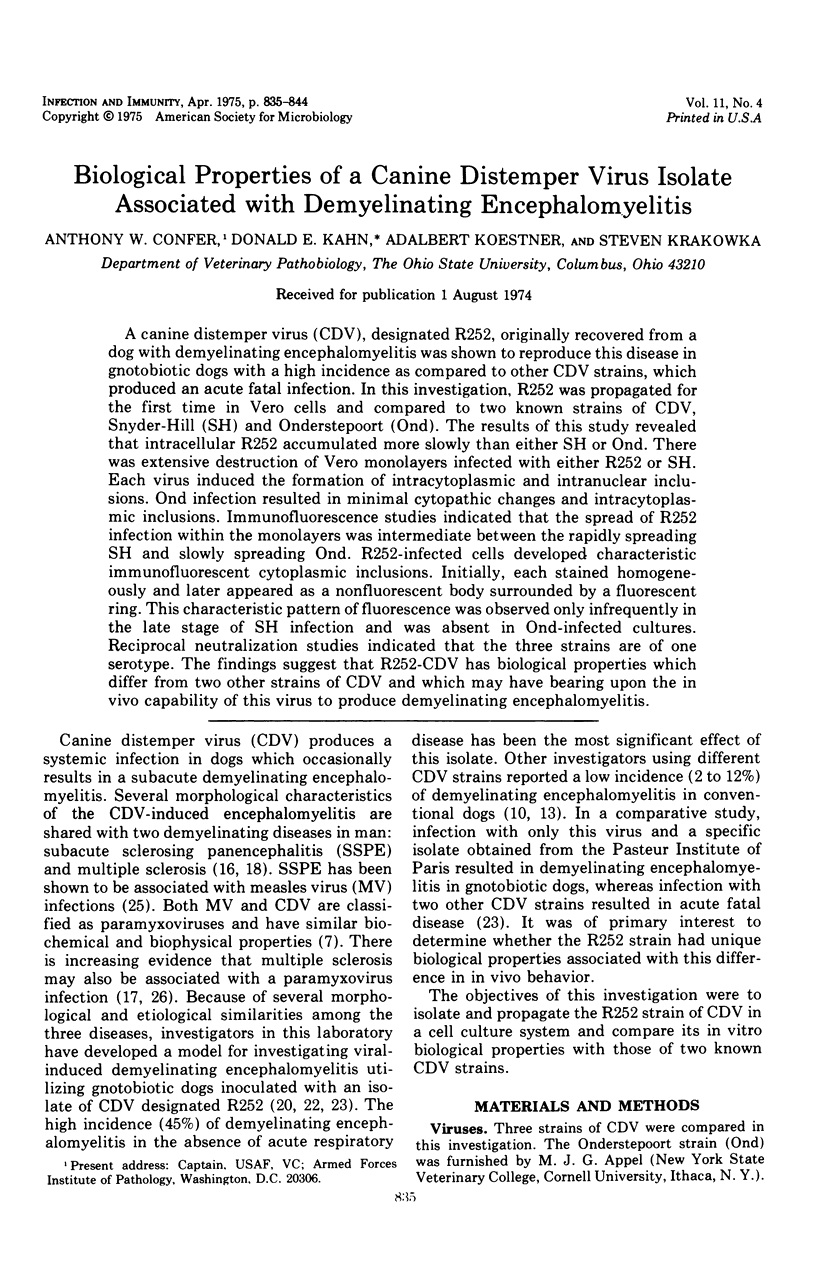
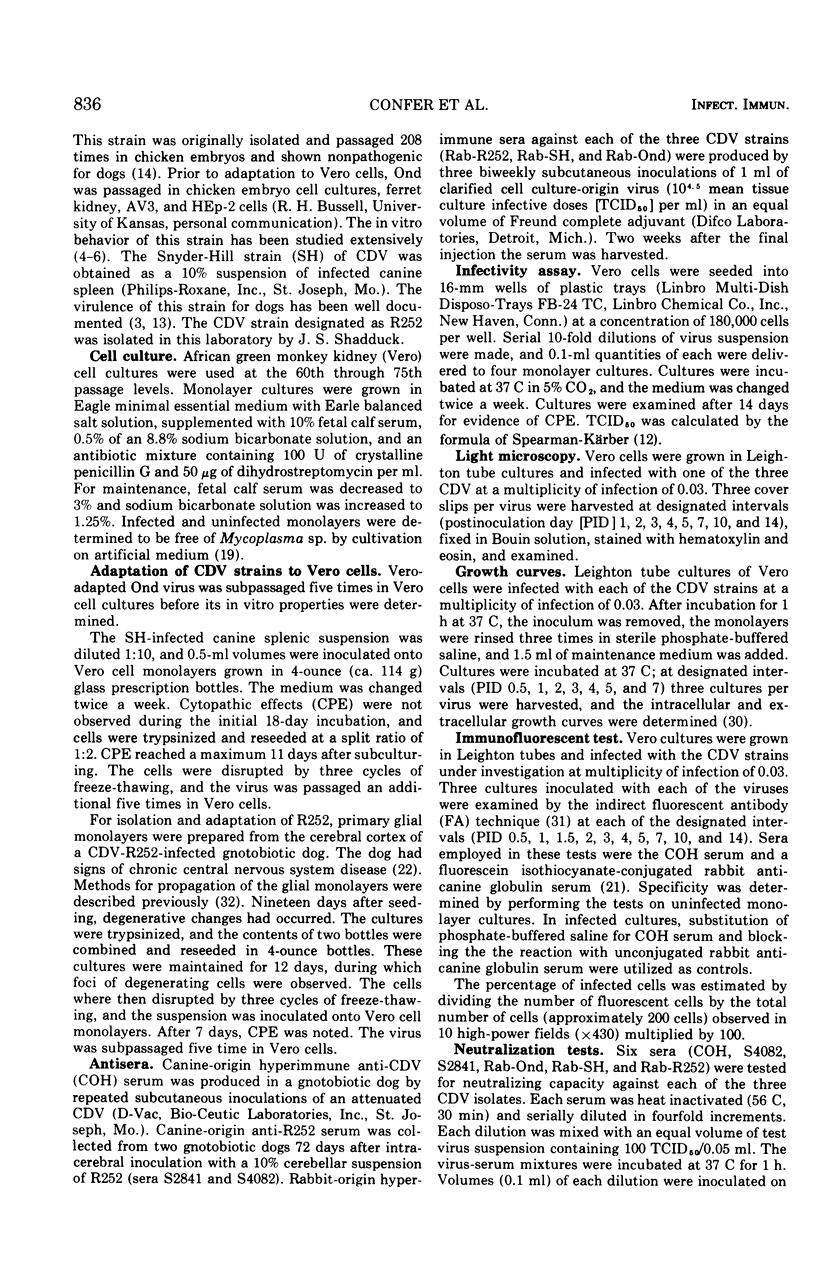
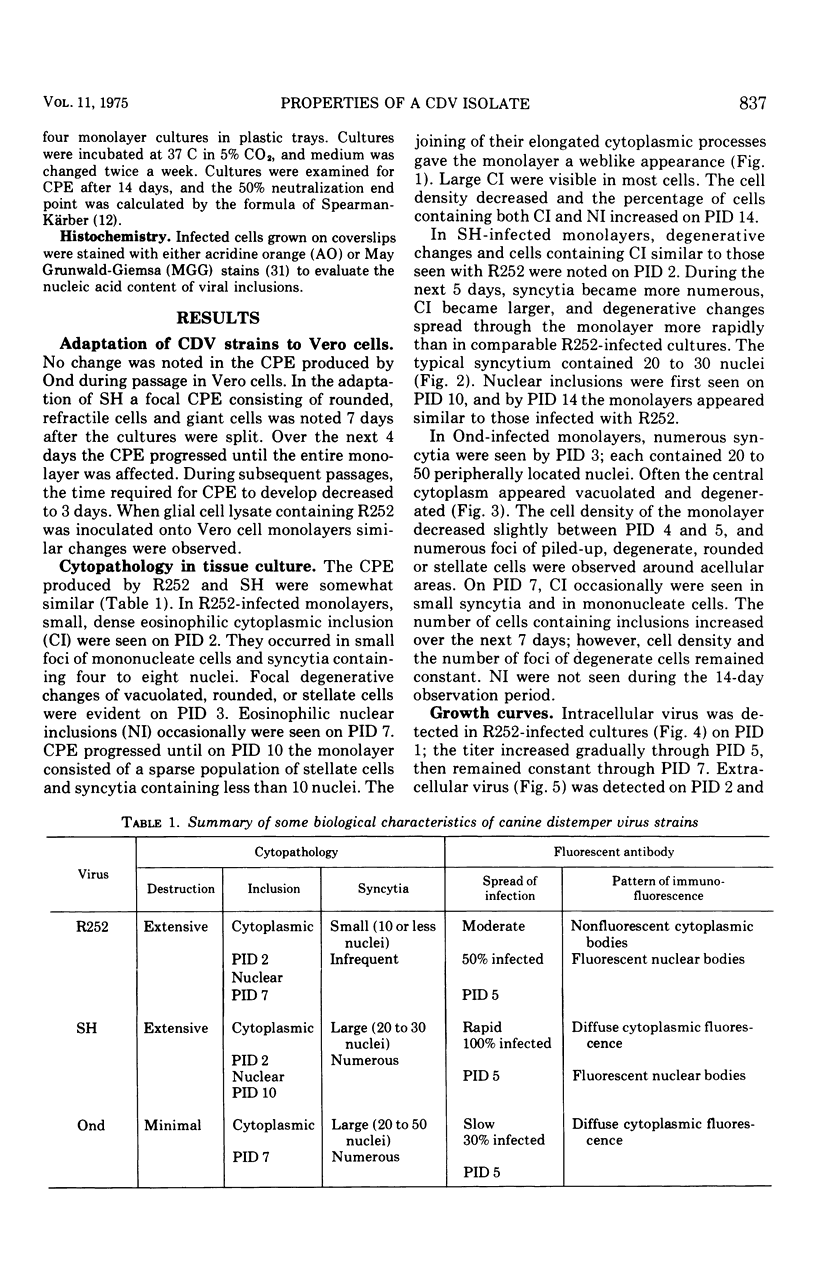
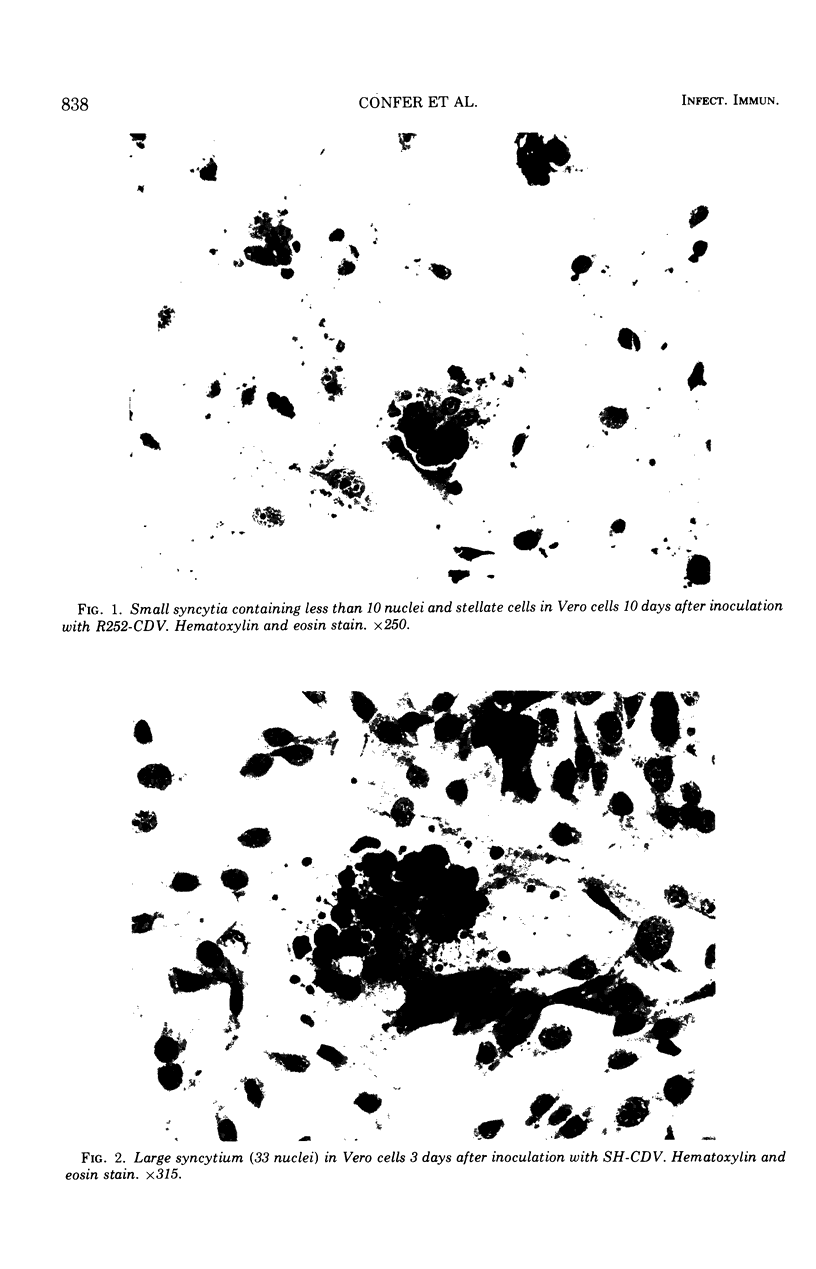
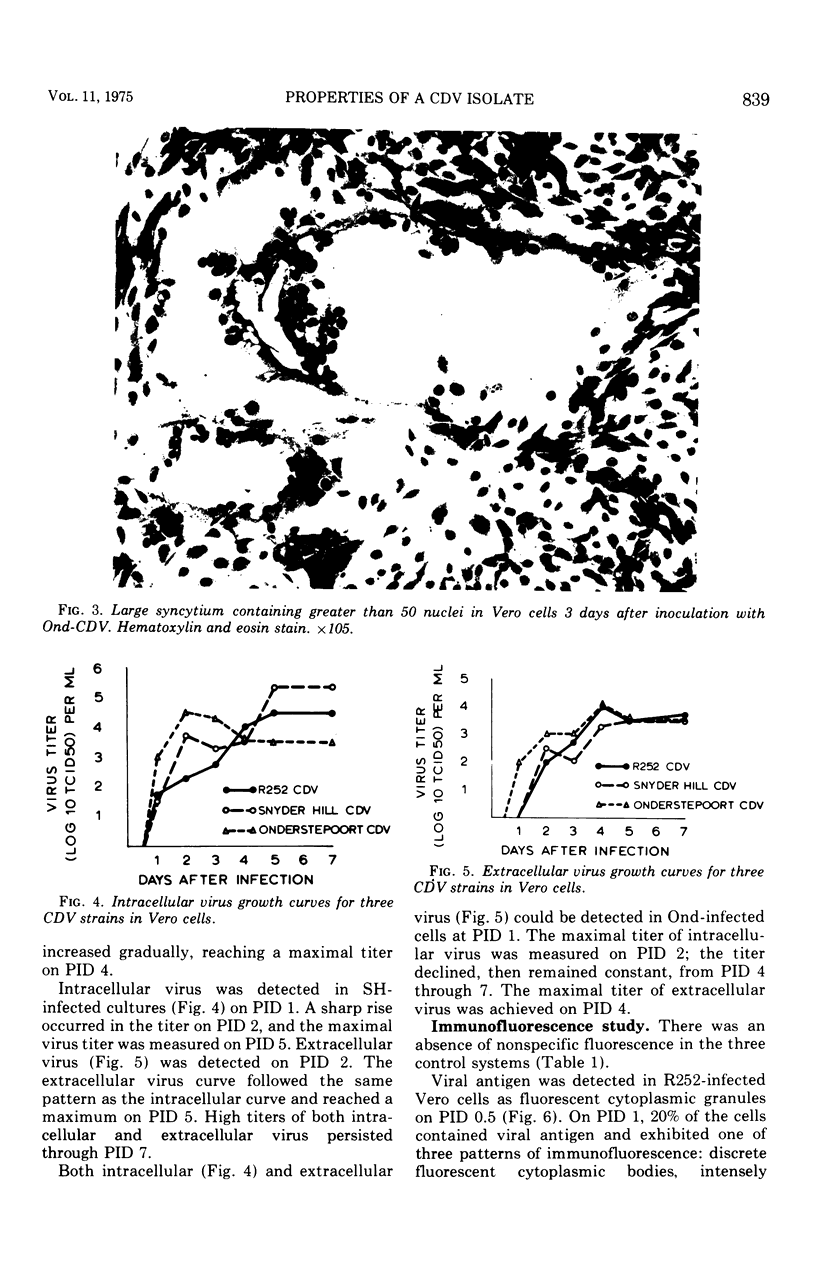
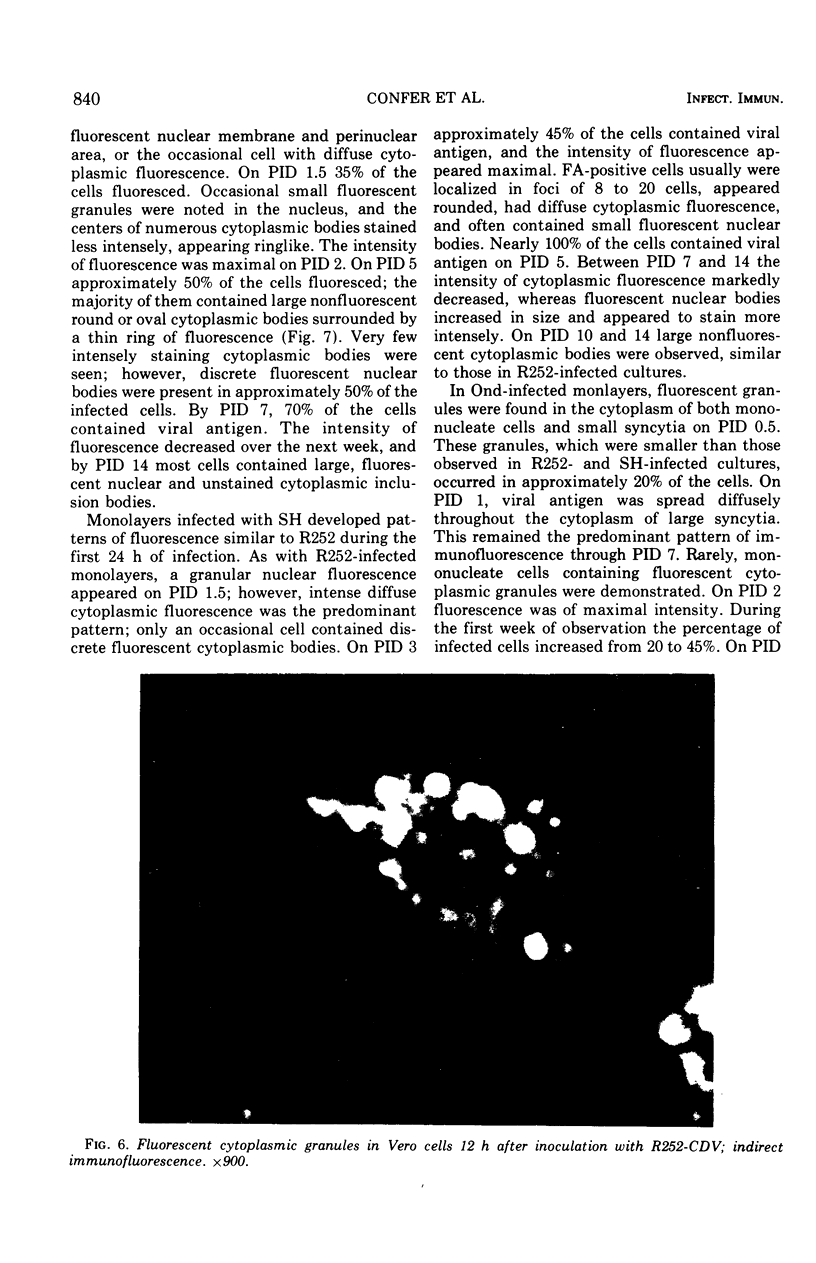
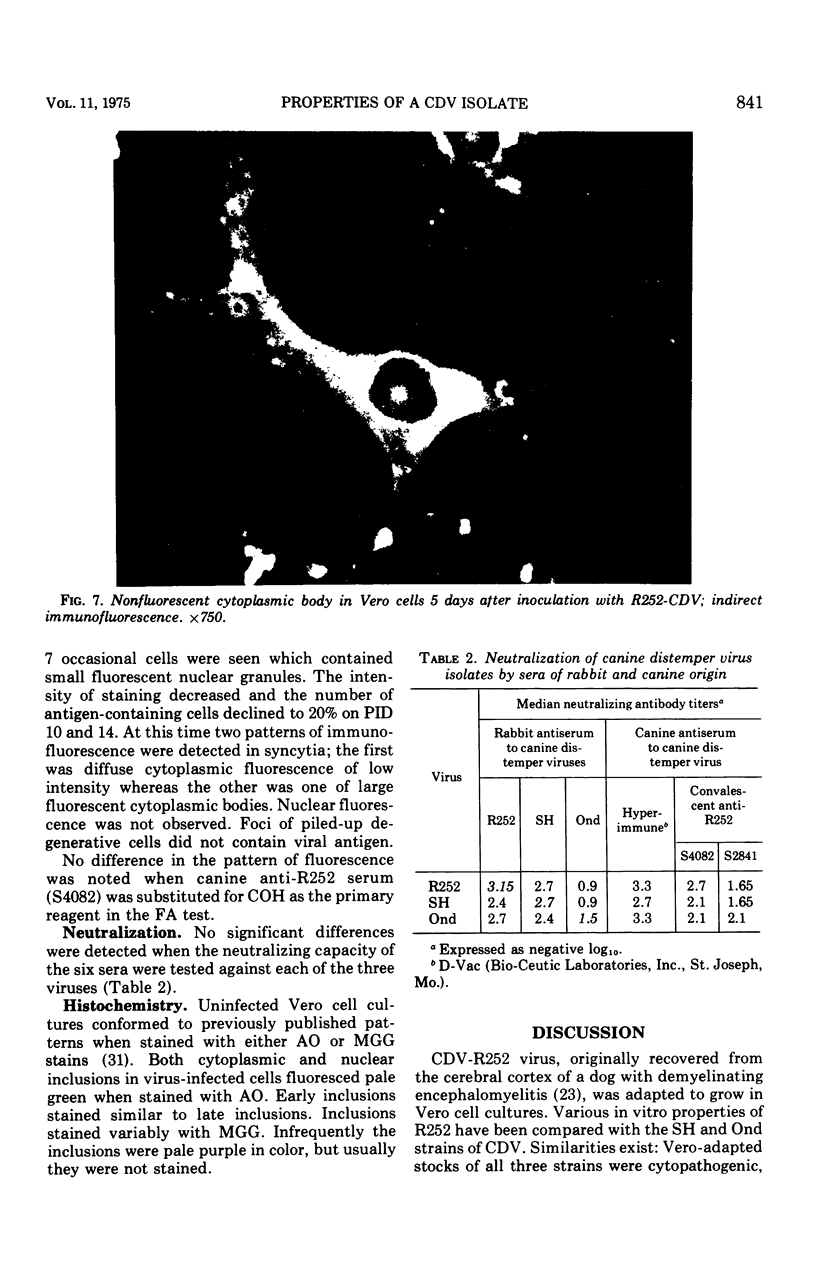
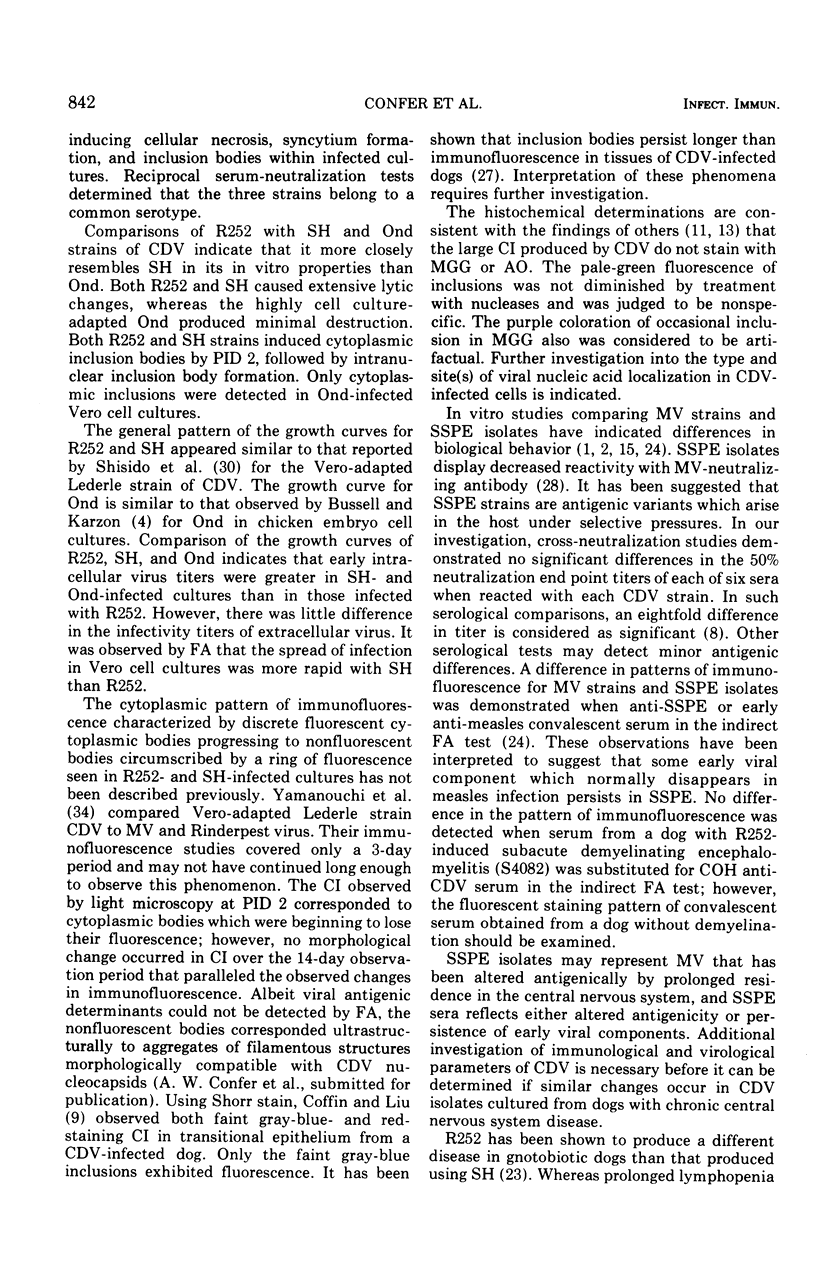
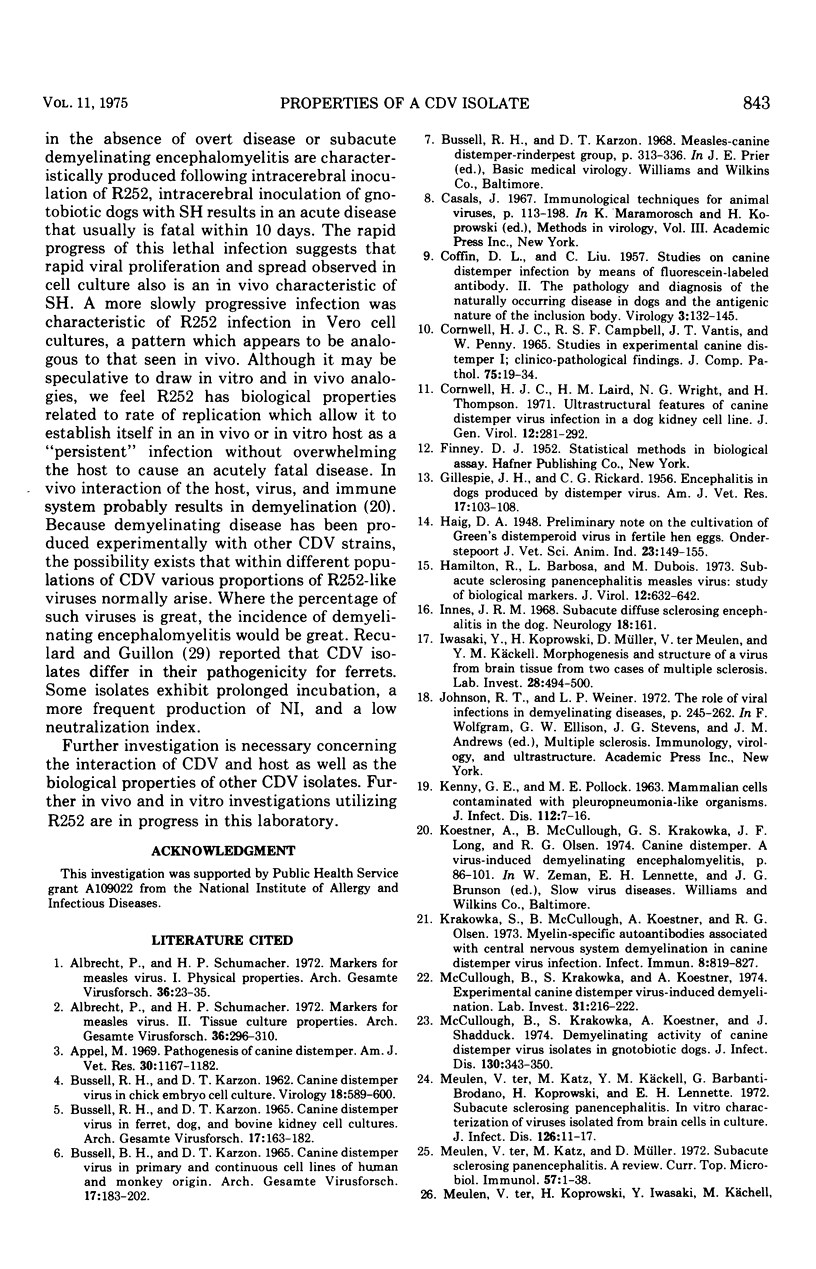
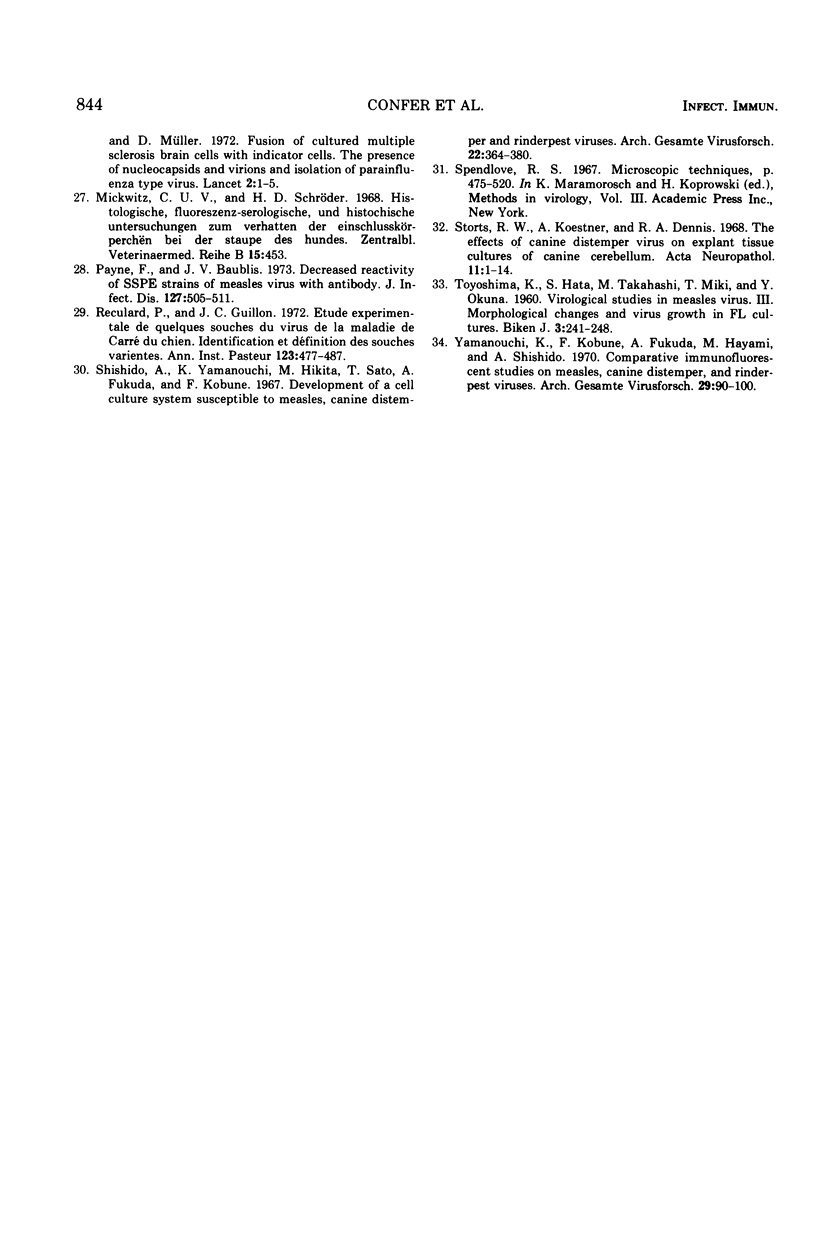
Images in this article
Selected References
These references are in PubMed. This may not be the complete list of references from this article.
- Albrecht P., Schumacher H. P. Markers for measles virus. I. Physical properties. Arch Gesamte Virusforsch. 1972;36(1):23–35. doi: 10.1007/BF01250292. [DOI] [PubMed] [Google Scholar]
- Appel M. J. Pathogenesis of canine distemper. Am J Vet Res. 1969 Jul;30(7):1167–1182. [PubMed] [Google Scholar]
- BUSSELL R. H., KARZON D. T. Canine distemper virus in chick embryo cell culture. Plaque assay, growth, and stability. Virology. 1962 Dec;18:589–600. doi: 10.1016/0042-6822(62)90062-4. [DOI] [PubMed] [Google Scholar]
- Bussell R. H., Karzon D. T. Canine distemper virus in ferret, dog and bovine kidney cell cultures. Arch Gesamte Virusforsch. 1965;17(2):163–202. doi: 10.1007/BF01267904. [DOI] [PubMed] [Google Scholar]
- COFFIN D. L., LIU C. Studies of canine distemper infection by means of fluorescein-labeled antibody. II. The pathology and diagnosis of the naturally occurring disease in dogs and the antigenic nature of the inclusion body. Virology. 1957 Feb;3(1):132–145. doi: 10.1016/0042-6822(57)90028-4. [DOI] [PubMed] [Google Scholar]
- Cornwell H. J., Laird H. M., Wright N. G., Thompson H. Ultrastructural features of canine distemper virus infection in a dog kidney cell line. J Gen Virol. 1971 Sep;12(3):281–292. doi: 10.1099/0022-1317-12-3-281. [DOI] [PubMed] [Google Scholar]
- GILLESPIE J. H., RICKARD C. G. Encephalitis in dogs produced by distemper virus. Am J Vet Res. 1956 Jan;17(62):103–108. [PubMed] [Google Scholar]
- Hamilton R., Barbosa L., Dubois M. Subacute sclerosing panencephalitis measles virus: study of biological markers. J Virol. 1973 Sep;12(3):632–642. doi: 10.1128/jvi.12.3.632-642.1973. [DOI] [PMC free article] [PubMed] [Google Scholar]
- Innes J. R. Subacute diffuse sclerosing encephalitis in the dog. Neurology. 1968 Jan;18(1 Pt 2):161–161. doi: 10.1212/wnl.18.1_part_2.161. [DOI] [PubMed] [Google Scholar]
- Iwasaki Y., Koprowski H., Müller D., ter Meulen V., Käckell Y. M. Morphogenesis and structure of a virus in cells cultured from brain tissue from two cases of multiple sclerosis. Lab Invest. 1973 Apr;28(4):494–500. [PubMed] [Google Scholar]
- KENNY G. E., POLLOCK M. E. Mammalian cell cultures contaminated with pleuropneumonia-like organisms. I. Effect of pleuropneumonia-like organisms on growth of established cell strains. J Infect Dis. 1963 Jan-Feb;112:7–16. doi: 10.1093/infdis/112.1.7. [DOI] [PubMed] [Google Scholar]
- Krakowka S., McCullough B., Koestner A., Olsen R. Myelin-specific autoantibodies associated with central nervous system demyelination in canine distemper virus infection. Infect Immun. 1973 Nov;8(5):819–827. doi: 10.1128/iai.8.5.819-827.1973. [DOI] [PMC free article] [PubMed] [Google Scholar]
- McCullough B., Krakowka S., Koestner A. Experimental canine distemper virus-induced demyelination. Lab Invest. 1974 Sep;31(3):216–222. [PubMed] [Google Scholar]
- McCullough B., Krakowka S., Koestner A., Shadduck J. Demyelinating activity of canine distemper virus isolates in gnotobiotic dogs. J Infect Dis. 1974 Oct;130(4):343–350. doi: 10.1093/infdis/130.4.343. [DOI] [PubMed] [Google Scholar]
- Payne F. E., Baublis J. V. Decreased reactivity of SSPE strains of measles virus with antibody. J Infect Dis. 1973 May;127(5):505–511. doi: 10.1093/infdis/127.5.505. [DOI] [PubMed] [Google Scholar]
- Reculard P., Guillon J. C. Etude experimentale de guelques souches du virus de la maladie de Carre du chien. Identification et definition des souches variantes. Ann Inst Pasteur (Paris) 1972 Oct;123(4):477–487. [PubMed] [Google Scholar]
- Schumacher H. P., Albrecht P., Tauraso N. M. Markers for measles virus. II. Tissue culture properties. Arch Gesamte Virusforsch. 1972;36(3):296–310. doi: 10.1007/BF01249860. [DOI] [PubMed] [Google Scholar]
- Shishido A., Yamanouchi K., Hikita M., Sato T., Fukuda A., Kobune F. Development of a cell culture system susceptible to measle, canine distemper, and rinderpest viruses. Arch Gesamte Virusforsch. 1967;22(3):364–380. doi: 10.1007/BF01242957. [DOI] [PubMed] [Google Scholar]
- Storts R. W., Koestner A., Dennis R. A. The effects of canine distemper virus on explant tissue cultures of canine cerebellum. Acta Neuropathol. 1968 Jul 8;11(1):1–14. doi: 10.1007/BF00692791. [DOI] [PubMed] [Google Scholar]
- Yamanouchi K., Kobune F., Fukuda A., Hayami M., Shishido A. Comparative immunofluorescent studies on measles, canine distemper, and rinderpest viruses. Immunofluorescence of measles, distemper, and rinderpest viruses. Arch Gesamte Virusforsch. 1970;29(1):90–100. doi: 10.1007/BF01253884. [DOI] [PubMed] [Google Scholar]
- ter Meulen V., Katz M., Käckell Y. M., Barbanti-Brodano G., Koprowski H., Lennette E. H. Subacute sclerosing panencephalitis: in-vitro characterization of viruses isolated from brain cells in culture. J Infect Dis. 1972 Jul;126(1):11–17. doi: 10.1093/infdis/126.1.11. [DOI] [PubMed] [Google Scholar]
- ter Meulen V., Katz M., Müller D. Subacute sclerosing panencephalitis: a review. Curr Top Microbiol Immunol. 1972;57:1–38. doi: 10.1007/978-3-642-65297-4_1. [DOI] [PubMed] [Google Scholar]
- von Mickwitz C. U., Schröder H. D. Histologische, fluoreszenz-serologische und histochemische Untersuchungen zum Verhalten der Einschlusskörperchen bei der Staupe des Hundes. Zentralbl Veterinarmed B. 1968 Jun;15(4):453–470. [PubMed] [Google Scholar]







